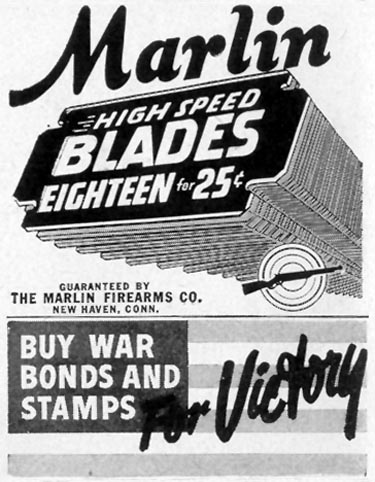Given that I don't want to do real work, I figured, hey, I'll take this out of the wall!
Long ago, when I owned a different house, my dad once told me that the little slot in the backs of these medicine cabinets was for the disposal of razor blades. You'd use the blade until it was too dull, but that left it too sharp for safe disposal, so you would just push it through the slot and it would fall down into the wall. I was never sure whether he was pulling my leg or not. But ...
 Marlin High Speed razor blades were a product of the Marlin Firearms Company of North Hampton, Connecticut. They started making razor blades in 1936 and phased them out sometime in the 50's or 60's (I'm not sure from my brief research). Those were obviously the last ones used and disposed of in the wall -- but upon inspection of the bottom of the pile, it appears that somebody really liked Marlin blades.
Marlin High Speed razor blades were a product of the Marlin Firearms Company of North Hampton, Connecticut. They started making razor blades in 1936 and phased them out sometime in the 50's or 60's (I'm not sure from my brief research). Those were obviously the last ones used and disposed of in the wall -- but upon inspection of the bottom of the pile, it appears that somebody really liked Marlin blades.There is one Gillette Blue Blade, with corner indents dating it to no earlier than 1933 (oh, Mr. Google, is there nothing you can't tell me?) It has arrows printed on it indicating the direction it was to be inserted into the razor; these were introduced in 1948.
Also at the bottom: one Silver Star Duridium blade; these were advertised around 1949 to 1950, attracting the attention of Linus Pauling in a letter dated June 14 of 1949. Also a Blue Star "FINEST BLUE STEEL" blade; those are still available today, making dating somewhat more difficult, but appear to be around 1950's vintage.
I am totally guessing 1949 as the year this apartment was first occupied. It is left as an exercise to the reader to calculate from the dimensions of the pile, the dimensions of a typical razor blade, and the number of days a blade could safely be used, just how many years this mostly-Marlin-using occupant lived here.
With, apparently, the occasional guest. At least, that's how I interpret single blades of other brands.
ReplyDeleteOh. I hadn't thought of that, but it makes sense! That, or occasionally his loyalty strayed due to advertisements, but in the end he just couldn't get a better shave than with blades from Marlin Firearms.
ReplyDeleteI found one blade packed back into its wrapper before being discarded.
Wow! Between you and Mr. Google (and Mr. Harmon), what an interesting little find.
ReplyDeleteIt was 1958 when I was seven that I, too, wondered about that slot in the back of the downstairs medicine cabinet. When told it was for used razor blades I was like, ...seriously? When assured that this was not a joke, I stumbled out the backdoor and into the yard where I walked aimlessly about pulling at hedge leaves trying to come to terms with this new and confusing information.
ReplyDeleteI had imagined this moment when some futurist discovered my father's used razor blades or those at a neighbor's who actually "disposed of" razor blades in such a manner (thank goodness my father didn't). I say "disposed of" because it struck me that this worn, rusting and dangerous artifact of our 1950's lives, carefully slide into the slot and clinking to the bottom of it's temporary holding cell, wasn't really gone, like real garbage - in the can, at the curb, in the truck, down the street, to the dump, where it would be mashed into dust - inert and harmless.
It was just lying there, behind nothing more then a thin piece of sheetmetal, while we slept, waiting for its moment, to inflict deep, mean, vengeful slices to flesh and to inject blood poisoning on the poor, unsuspecting soul who would inevitably come upon the pile of reddish brown sheaves, disguised and softened by time into something that looked more like a web of dirt than the lethal booby trap that it would become.
I worried that the person who fate had chosen, that would eventually stumble upon the razor blade purgatory, might not realize what it was and would carelessly reach out with open palm to sweep the lump of disguised peril into the dust pan and in that one false move, they'd be bleeding and screaming and maybe even get meningitis.
I just couldn't believe that this method of razor blade disposal was the best that modern man could do. And now, thanks to your discovery and pictures, my fear is confirmed - it's gross and with one misstep you could have been out of commission and the family is due in just a few days... Thank goodness you were not injured.
I used a knife to lift them and pull blades out, and was very careful not to cut myself when picking single blades up. The weird thing: no rust. I mean, a thin veneer of rust, almost a tarnish, but not the red-dust heap you'd expect. Apparently the interior of the bathroom wall is a drier environment than I would have anticipated.
ReplyDeleteHow bizarre! I've got a vintage razor that takes that sort of blade, and the packages of blades you can buy now have a slot for used blades on the back, that keeps them safely contained until you throw the spent pack in the trash.
ReplyDeleteThis makes me want to tear out our bathroom medicine cabinet just to see what I find back there.
ReplyDelete